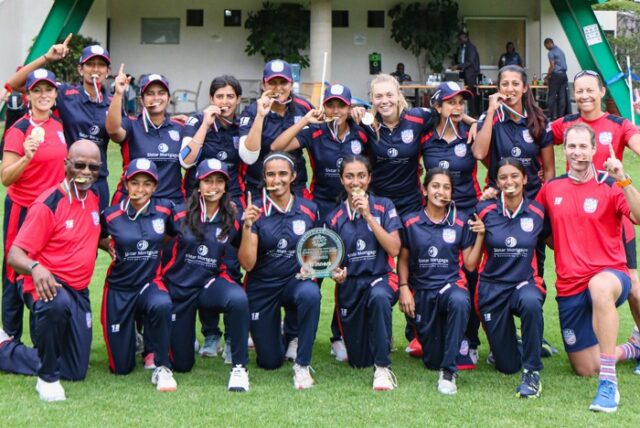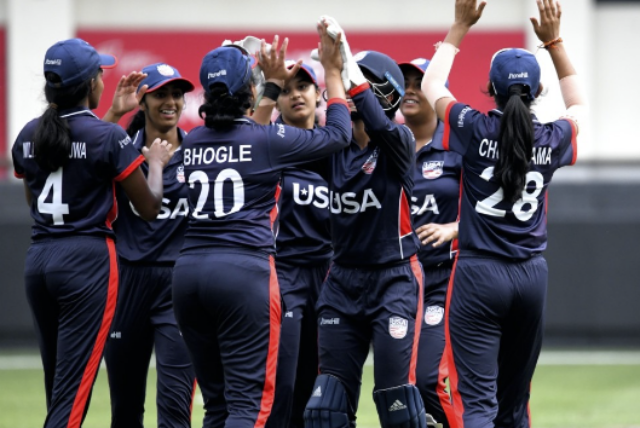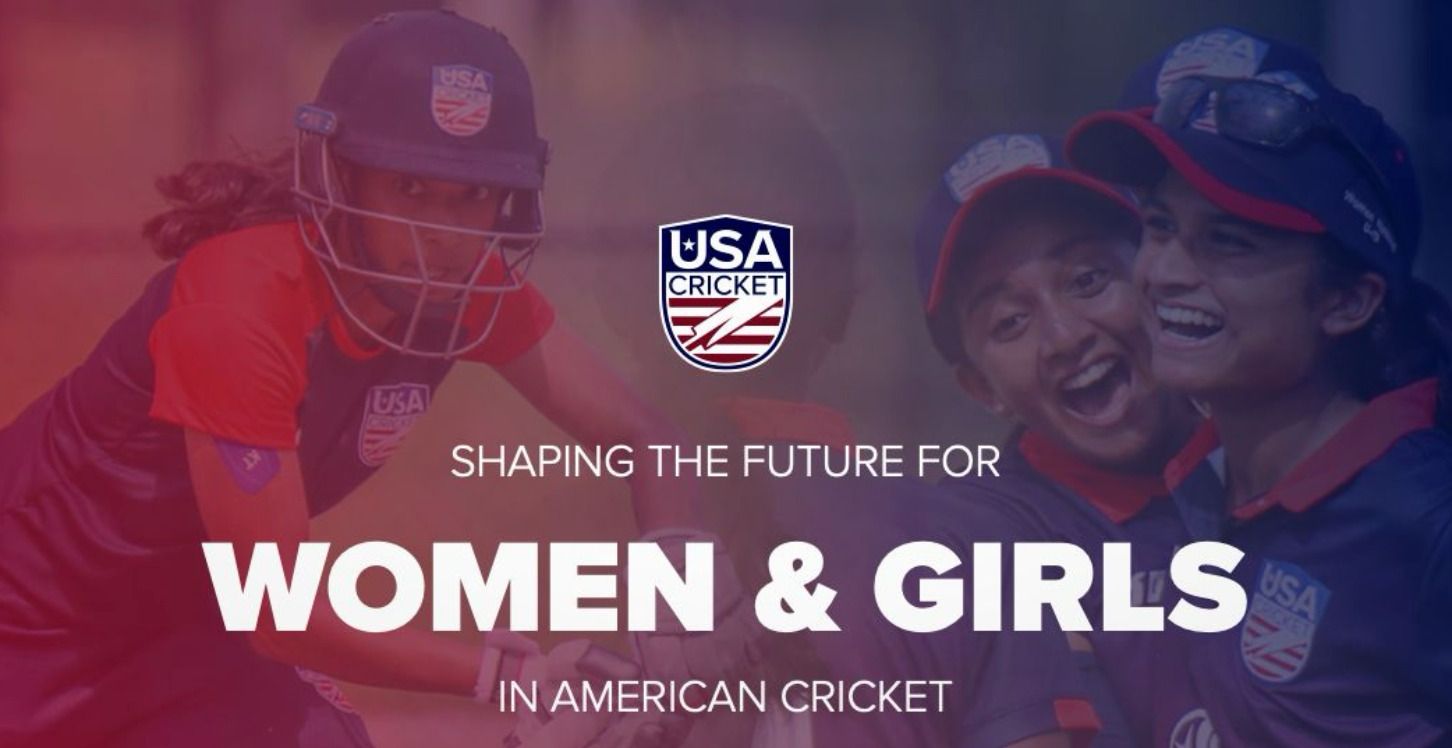By Aamani Dhingra
In colleges across the United States, you will find a distinct group of students going from lecture halls to practice fields, carrying textbooks in one hand and equipment in the other. Yet, for many of these students, balancing academic studies and athletic pursuits is not just a challenge but a lifestyle.
Student-athletes face high expectations both on the field and in the classroom. They must carefully plan their schedules to accommodate workouts, practice sessions, and academic requirements. Like their peers, they feel the pressure to perform well on exams, but they also have the added responsibility of excelling in games.
 Cricket players Laasya Mullapudi, Disha Dhingra, Gargi Bhogle, and Bhumika Bhadriraju show that although it can be challenging, managing both academics and athletics is possible with support and determination.
Cricket players Laasya Mullapudi, Disha Dhingra, Gargi Bhogle, and Bhumika Bhadriraju show that although it can be challenging, managing both academics and athletics is possible with support and determination.
While cricket is gaining popularity in the US, it still faces unique challenges that other sports do not experience. The National Collegiate Athletic Association (NCAA), an organization that coordinates the athletic programs of colleges, does not recognize cricket as an official NCAA sport. This means that cricket-playing college students miss out on the benefits enjoyed by NCAA athletes, including access to facilities and scholarships.
Laasya Mullapudi, a first-year student at UCLA, feels this gap firsthand: “If cricket were a more noticed and accredited sport in college, it would be much easier to handle academics as well.”

Balancing sports with academics is not without its challenges. Navigating these challenges often involves tough decisions and sacrifices. Bhumika Bhadriraju, a student at UNC-Chapel Hill and Duke University, recounts how she “…had to drop the Americas regional qualifiers tour for USA in order to prioritize [her] education.” It was a hard choice for her, but ultimately, she knew she “had to put [her] education first.” Many student-athletes face this same dilemma, uncertain about whether to prioritize sports or studies.
In the face of these challenges, a support system is crucial. Whether it is teammates, coaches, or family, having a network of people to help you can make all the difference in balancing cricket and college life. Gargi Bhogle, a senior at Concordia University Irvine, emphasizes the important role her family plays in both her academic and cricketing journey.
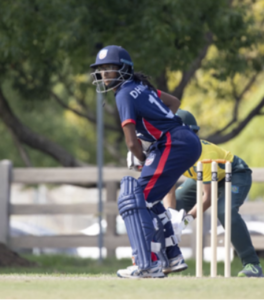 She says that they help her stay focused and encourage her to set time aside for practice and workouts regardless of her academic workload.
She says that they help her stay focused and encourage her to set time aside for practice and workouts regardless of her academic workload.
This dynamic is familiar to many student-athletes, whose college decisions are often shaped by their desire to excel in both athletics and education. Sports programs and facilities offered by colleges often play a pivotal role in this decision-making process.
For Disha Dhingra, a senior at Old Bridge High School, choosing the right college is a difficult decision, requiring careful consideration of how each institution supports her athletic and academic goals. She acknowledges that the challenge of balancing high school and cricket has been significant, and she anticipates a heightened difficulty managing these responsibilities once she starts college. Therefore, she is looking for a college that aligns with cricketing aspirations” but is also supportive and flexible with time commitments.
Balancing academic responsibilities and cricket commitments requires strategic planning, effective time management skills, and clear communication. For those students who aspire to pursue their passion for sports while excelling academically, our players have valuable insights and tips. Bhogle recommends “writing out a to-do list every couple of days” to keep track of due dates. She also touches on mental health, emphasizing that “taking care of your mental health is just as important as caring for your body.” Mullapudi encourages students to “recognize that challenges will arise, but to persevere because of [their] own motivation,” not because of external pressures.
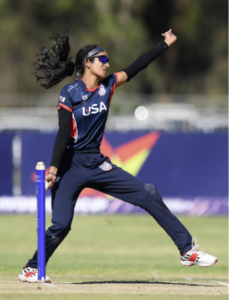 The journey of balancing cricket and college is complex and often filled with tough decisions and challenges. However, we have seen firsthand that once you find that perfect balance, it becomes a rewarding and enjoyable endeavor. As cricket’s popularity continues to grow in the United States, it is important to think about what can be done to make it easier for students to balance both cricket and college.
The journey of balancing cricket and college is complex and often filled with tough decisions and challenges. However, we have seen firsthand that once you find that perfect balance, it becomes a rewarding and enjoyable endeavor. As cricket’s popularity continues to grow in the United States, it is important to think about what can be done to make it easier for students to balance both cricket and college.
Bhadriraju proposes the creation of “a USA cricket contract” which would “allow female athletes to take multiple months off at a time and not worry about their career…” By advocating for improvements, we can pave the way for a future where balancing cricket and college becomes less of a challenge and more of a fulfilling and enriching journey for all.
Steps must be taken to ensure that players are not forced to choose between cricket and studies. Whether this includes advocating for cricket’s recognition as an official NCAA sport, ensuring access to facilities and scholarships, or fostering a supportive environment, we must advocate for ways to make this decision easier. These players spend years of dedication and hard work improving their cricketing skills, yet when the time comes for them to go to college, many find themselves having to leave their passion for cricket to pursue their education. This predicament poses a significant threat to cricket’s future in the US. If players are forced to choose between their education and cricket, we risk stunting the growth and development of cricket. Therefore, it is crucial to address these challenges and find solutions that enable students to pursue both academics and cricket, both for the players’ future as well as the future of cricket in the US.



